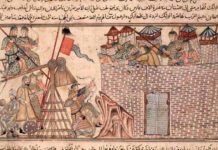With a population of a little over six million, the Lao People’s Democratic Republic in south east Asia is still an idyllic country. With no access to the sea it is land-locked by Thailand, Burma,China, Vietnam and Cambodia
Prince Fa Ngum – Founder of Lao Kingdom
The kingdom was founded by prince Fa Ngum – who as a little boy found refuge with his father Prince Yak Fa in the court of the Cambodian king Jayavarman Parameshvara (1327 – 1353) at Angkor after Yak Fa was banished from his own country, one of the small principalities in northern Indo-China. The little prince grew up in the Cambodian (Khmer) court . In due course King Jayavarman Paramesvara gave his own daughter, Nang Keo-Keng-Ya in marriage to Prince Fa Ngum – and provided him with an army to reclaim his country of birth.
With this military assistance from his father in law, Fa Ngum conquered the Lao territories, and in 1353, he founded the kingdom of Lan Xang (present-day Laos). The name Lan Xang means ‘ a million elephants,
When the Cambodian princess Nang Keo-Keng-Ya found that the people in Laos believed in cults of spirits and performed animal sacrifices, she being a devout Buddhist, requested her husband to introduce Buddhism in his new kingdom. King fa Ngum thus requested the Cambodian king to send a Buddhist mission to Lan Xang.
Buddhist Missionaries
According to the Wat Keo inscription in Luang Prabang dated 1602 AD, King Jayavarman Paramesvara responded to this request by sending a team of Buddhist missionaries headed by three Sri Lankan monks to Lan Xang. These three Sri Lankan monks were Mahadeva Lanka Thero (Phra Mahatep Lanka), Deva Lanka Thero (Phra Tep Lanka) and Maha Nandipanna Thero. A gold Buddha image called Prabang that had been gifted to Cambodia in 1056 AD by the Sri Lankan king Vijayabahu I (1055-1110 AD) was brought to Lan Xang by the mission, together with copies of the Buddhist scriptures, the Tripitaka. The new capital city of King Fa Ngum was named Luang Prabhang after this image.
The mission also brought a sapling from the sacred Bo tree in Anuradhapura in Sri Lanka and according to the Sri Lankan tradition this was ceremoniously planted in the new capital. A Buddhist temple (wat) which came to be called Wat Po Lanka (the temple of the Sri Lanka Bo tree) was constructed near the Bo tree, complete with quarters for the monks and a sacred chedi (zhedi or chaithya).
King Fa Ngum subsequently appointed Phra Mahatep Lanka as the first Sangharaja (Chief Monk) of Laos. After he died, he was succeeded by Maha Pasaman, the Cambodian monk who had been Fa Ngum’s childhood teacher at Angkor.
The introduction of Theravada Buddhism from Sri Lanka not only served as a symbol of legitimisation of Fa-Ngum’s authority, but also as an important factor to unify and consolidate the new Lao state.
The Prabang Buddha Image
The Prabang image of the Buddha that was brought by the Buddhist missionaries is believed to have been cast from a mixture of gold, silver, and bronze in 874 AD by a Buddhist monk, Cunnaka Thero in Sri Lanka and was presented to the Khmer King Phaya Sirichantha when he embraced Theravada Buddhism in the 11th century. The sacred image is 83 centimeters tall and weighs 54 kilograms. It portrays the Buddha standing with arms raised forward at the elbows with the palms facing forward. This hand gesture is known as Abhaya Mundra and signifies assurance and protection.
The image is today considered to be the sacred palladium of the Lao nation and is believed to possess extremely protective powers, It is now kept in the museum in Luang Prabang the old Royal City situated on a peninsula at the confluence of the Khan and Mekong rivers, and is the country’s most protected national treasure.








